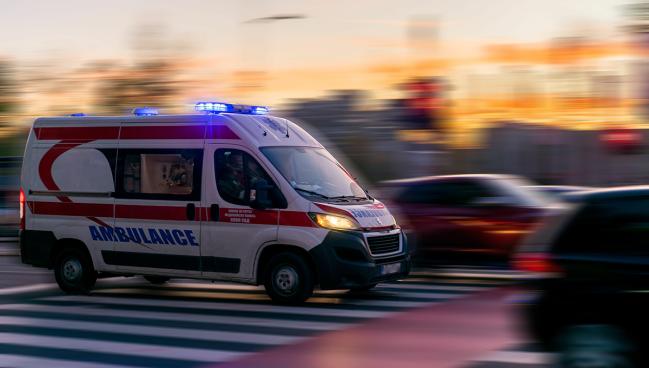Lower Risk of Mortality for Shock Patients Transferred to Expert Centers
The US data also point to lower costs and shorter stays at these expert centers, an argument for regionalized care akin to STEMI.

Patients with cardiogenic shock have lower in-hospital mortality, as well as shorter, cheaper hospital stays, if transferred to expert hub centers, according to new US data.
Yet just one in 10 people with cardiogenic shock were transferred, researchers report in their paper published earlier this month in Circulation: Heart Failure.
“The good news is, yes, transfer of patients to a hub shock center is associated with better outcomes. So, that’s the first positive signal,” senior author Saraschandra Vallabhajosyula, MD (Brown University, Providence, RI), told TCTMD.
This advantage was consistent across subgroups, even though the transferred patients were higher risk overall, with more comorbidities and organ failure, than those who stayed at the presenting hospital.
Shock care presently is “very fragmented, very location specific, and there is a very limited amount of evidence that guides our therapies,” said Vallabhajosyula. This has spurred interest in more consistency through shock centers of excellence, protocols, dedicated teams, and the like, as well as through regionalized systems of care that pull together resources and expertise.
“There are many tangibles and intangibles that go into improving patient outcomes in this population,” he told TCTMD. “[This complexity] is not just restricted to the physicians who are involved, but in the processes of care and just how the multidisciplinary input is built. “
As has been successfully done before in STEMI networks, the hub-and-spoke model is gaining traction for cardiogenic shock, said Vallabhajosyula. But the literature thus far comes mainly from self-selected, experienced centers who sign up to take part in research, which means the data don’t capture the entirety of what’s happening in practice. For instance, a 2023 paper from the Cardiogenic Shock Working Group (CSWG) found that transferred patients “actually do worse,” he noted.
There are many tangibles and intangibles that go into improving patient outcomes in this population. Saraschandra Vallabhajosyula
Claudius Mahr, DO (Medical City Healthcare, Dallas, TX), commenting on the study for TCTMD, highlighted just how few with cardiogenic shock were transferred.
With STEMI care, by contrast, the majority of patients follow a set pathway, he explained. “The field has accepted that when you have an ECG that shows a STEMI, a system of care kicks in place and it’s pretty much foolproof: you’re going to go to a cath lab, and there is accountability in terms of a care pathway that results in the key performance metric of the door-to-balloon time. It pretty much works irrespective of the setting.” The same consistency exists in trauma care, Mahr noted.
This is not the first time researchers have shown better outcomes for shock patients with transfer, he added. “There’s a whole body of evidence in this space, but up until this point, this has not resulted in improvement and a true system of care.”
Mahr stressed that this study, building on others that preceded it, “should compel us to move towards a more cohesive system of care for cardiogenic shock: a system that has key performance indicators [as well as] guardrails around it.” Accountability, he said, will result in better outcomes.
In-Hospital Mortality Consistently Lower
For this study, led by Vallabhajosyula and well as first authors Shubhadarshini Pawar, MBBS, and Kannu Bansal, MD (both from Brown University), researchers turned to the National Readmissions Database (NRD) in an attempt to avoid confounders. They included 314,098 patients (38% women) with a primary or secondary diagnosis of cardiogenic shock from 2016 to 2020, stratifying them by transfer status. Around a quarter (27%) of cases were related to acute MI, while the rest were not. In all, 9.8% of patients were transferred to an expert center.
Transferred patients tended to be younger (mean 65 vs 68 years), have more comorbidities, and were more likely to be treated at large teaching hospitals than were nontransferred patients. During their hospital stay, they were more apt to experience renal failure, be monitored via pulmonary artery catheter, and receive mechanical circulatory support.
For patients transferred to a hub, in-hospital mortality was lower (39.1% vs 47.1%; adjusted OR 0.73; 95% CI 0.71-0.76), a pattern that extended across subgroups no matter patients’ age, sex, cause of shock, hospital location, receipt of mechanical circulatory support, or whether they had cardiac arrest. With adjustment for confounders, the cost of caring for transferred patients amounted to 28% of the cost for nontransferred patients. Length of stay for those transferred was 24% of the duration seen in patients who weren’t transferred.
However, 30-day readmissions were significantly increased among transfer patients, including return visits for all-cause (adjusted OR 1.21), cardiac (adjusted OR 1.16), heart failure (adjusted OR 1.14), and noncardiac reasons (adjusted OR 1.68).
Yet at a lot of community hospitals, patients will linger there until they’re almost irretrievable and deteriorate in terms of their shock stage. Claudius Mahr
The data also suggest that patients with shock are often underdiagnosed, Mahr observed. “They’re undertriaged, and frequently, they remain too long in settings in which definitive care is not available.” If they end up needing escalation to mechanical circulatory support, he added, “we know the outcomes are better [when that’s done] before there is end-organ dysfunction and damage. Yet at a lot of community hospitals, patients will linger there until they’re almost irretrievable and deteriorate in terms of their shock stage.”
Not all cardiogenic shock patients should be transferred, he acknowledged. “There are definitely cases that appropriately can stay in the community setting, but I think that the key is we’ve shown in the [CSWG] that there’s a 50% chance that patients will deteriorate in the first 24 hours.” This means that clinicians shouldn’t just consider how a patient presented, but also should proactively risk stratify during this time in case the situation changes, said Mahr.
“We need regionalized networks,” he concluded. “Hospitals and health systems are going to have to decide how much they want to invest into caring for these types of patients, and that’s going to look different from hospital to hospital and from health system to health system. But I think hopefully the days of shock patients being underdiagnosed, undertriaged, and their escalation of care getting delayed will come to an end once people acknowledge the magnitude of the problem.”
It’s still early days for regionalized shock care, Vallabhajosyula agreed. For the most part, the models are being developed by individual healthcare systems, though some are ad hoc and mimic existing strategies for transfer. An American Heart Association scientific statement, published in 2017, endorses using high-volume cardiogenic shock centers in a hub-and-spoke approach.
Vallabhajosyula said that STEMI networks could serve as a guide in these efforts. “The difference here is, unfortunately unlike STEMI care, we don’t have such high-quality, unambiguous data,” he pointed out. “There have been [only] two randomized trials over 25 years that have shown some signal of positivity. So, it’s just a challenge.”
The data supporting better shock outcomes with transfer “are in line with common sense,” Vallabhajosyula stressed. So, next steps for research include trying to understand “the healthcare economics of why [transfer] does not happen,” as well as “bare-bones logistics” like staffing and bed capacity, he said.
Correction: An earlier version of this story mistakenly attributed Vallabhajosyula's quotes to first author Shubhadarshini Pawar.
Caitlin E. Cox is News Editor of TCTMD and Associate Director, Editorial Content at the Cardiovascular Research Foundation. She produces the…
Read Full BioSources
Pawar S, Bansal K, Abbott JD, et al. Transfer to hub hospitals and outcomes in cardiogenic shock. Circ Heart Fail. 2025;18:e012477.
Disclosures
- Pawar and Vallabhajosyula report no relevant conflicts of interest.
- Mahr reports being an investigator/consultant for the Cardiogenic Shock Working Group, Abbott, and Abiomed.





Comments